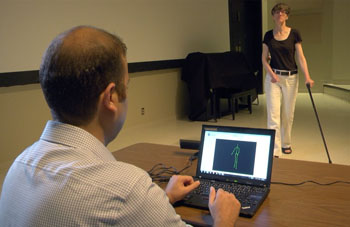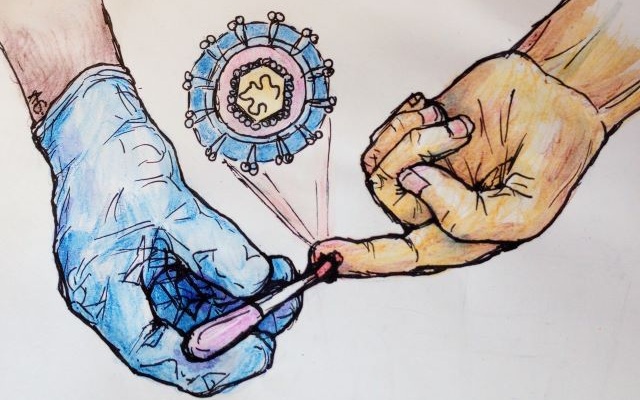Interactive Video Gaming Device Could Aid MS Patients
|
By LabMedica International staff writers Posted on 23 Aug 2016 |

Image: Using Kinect motion-capture camera may improve evaluation of gait pathology in multiple sclerosis patients by increasing objectivity in diagnosis and treatment monitoring (Photo courtesy of the Montreal Neurological Institute & Hospital and McGill University).
A commonly used 3D depth-sensing camera could become a low-cost means of monitoring treatment effectiveness for walking difficulties of patients with gait-impairing diseases such as multiple sclerosis (MS).
The Microsoft “Kinect” motion-detection camera can be hooked up to an Xbox gaming console or a Windows computer for interactive video activities such as tennis and dancing. A team of researchers led by McGill University (Montreal, Quebec, Canada) postdoctoral fellow Farnood Gholami, supervised by Prof. Jozsef Kövecses, collaborated with Daria Trojan, physiatrist at the Montreal Neurological Institute and Hospital, to test whether the Kinect could detect the differences in gait of MS patients compared to healthy individuals. The tool could be useful “to assess treatment effects of certain interventions such as rehabilitation or medication, and to document MS disease progression as reflected by gait deterioration. It may also be useful as a measure in clinical trials,” said Trojan. Additional collaboration was with Behnood Gholami at AreteX Systems Inc. (Hoboken, NJ, USA) and Wassim M. Haddad at Georgia Institute of Technology, (Atlanta, GA, USA).
In current clinical practice, the walking movement of MS patients is usually assessed by their doctors using subjective evaluations that may distort results such that different clinicians may give different evaluations for the same patient. Using computer algorithms that quantify patient walking patterns detected by a camera can reduce potential for human error.
Using Kinect, Dr. Gholami captured the movement of 10 MS patients and 10 members of an age-and-sex-matched control group. The MS patients had previously been assessed for gait abnormalities using the traditional clinician method. Using the data, the team then developed computer algorithms that quantified gait characteristics of MS patients and healthy people. They found that gait characteristics measured with the Kinect camera and analyzed with the developed algorithms were reproducible when assessed at one visit and were different between MS patients and the healthy individuals. Moreover, the gait characteristics of MS patients obtained by the algorithm were correlated with clinical measures of gait. In addition, the algorithms could mathematically define the characteristics of gait in MS patients at different severity levels, accurately determining the level of gait abnormality.
Dr. Gholami became interested in using motion-capture technology for clinical purposes as a PhD student, but the equipment he was using at the time was very expensive, difficult to use, and non-portable, making widespread clinical use prohibitive. Kinect is an inexpensive tool that appears to be accurate enough to do the job. “This tool may help the clinician provide a better diagnosis of gait pathology, and may be used to observe if a prescribed medication has been effective on the gait of the patient or not,” he said, “Our developed framework can likely be used for other diseases causing gait abnormalities as well, for instance Parkinson’s disease.” The next step is to conduct a study with a larger group of MS patients, including evaluation in a gait laboratory, using a newer version of the Kinect device to improve accuracy.
The study, by Gholami F et al, was published July 21, 2016, in the IEEE Journal of Biomedical and Health Informatics.
Related Links:
McGill University
The Microsoft “Kinect” motion-detection camera can be hooked up to an Xbox gaming console or a Windows computer for interactive video activities such as tennis and dancing. A team of researchers led by McGill University (Montreal, Quebec, Canada) postdoctoral fellow Farnood Gholami, supervised by Prof. Jozsef Kövecses, collaborated with Daria Trojan, physiatrist at the Montreal Neurological Institute and Hospital, to test whether the Kinect could detect the differences in gait of MS patients compared to healthy individuals. The tool could be useful “to assess treatment effects of certain interventions such as rehabilitation or medication, and to document MS disease progression as reflected by gait deterioration. It may also be useful as a measure in clinical trials,” said Trojan. Additional collaboration was with Behnood Gholami at AreteX Systems Inc. (Hoboken, NJ, USA) and Wassim M. Haddad at Georgia Institute of Technology, (Atlanta, GA, USA).
In current clinical practice, the walking movement of MS patients is usually assessed by their doctors using subjective evaluations that may distort results such that different clinicians may give different evaluations for the same patient. Using computer algorithms that quantify patient walking patterns detected by a camera can reduce potential for human error.
Using Kinect, Dr. Gholami captured the movement of 10 MS patients and 10 members of an age-and-sex-matched control group. The MS patients had previously been assessed for gait abnormalities using the traditional clinician method. Using the data, the team then developed computer algorithms that quantified gait characteristics of MS patients and healthy people. They found that gait characteristics measured with the Kinect camera and analyzed with the developed algorithms were reproducible when assessed at one visit and were different between MS patients and the healthy individuals. Moreover, the gait characteristics of MS patients obtained by the algorithm were correlated with clinical measures of gait. In addition, the algorithms could mathematically define the characteristics of gait in MS patients at different severity levels, accurately determining the level of gait abnormality.
Dr. Gholami became interested in using motion-capture technology for clinical purposes as a PhD student, but the equipment he was using at the time was very expensive, difficult to use, and non-portable, making widespread clinical use prohibitive. Kinect is an inexpensive tool that appears to be accurate enough to do the job. “This tool may help the clinician provide a better diagnosis of gait pathology, and may be used to observe if a prescribed medication has been effective on the gait of the patient or not,” he said, “Our developed framework can likely be used for other diseases causing gait abnormalities as well, for instance Parkinson’s disease.” The next step is to conduct a study with a larger group of MS patients, including evaluation in a gait laboratory, using a newer version of the Kinect device to improve accuracy.
The study, by Gholami F et al, was published July 21, 2016, in the IEEE Journal of Biomedical and Health Informatics.
Related Links:
McGill University
Latest Technology News
- Pioneering Blood Test Detects Lung Cancer Using Infrared Imaging
- AI Predicts Colorectal Cancer Survival Using Clinical and Molecular Features
- Diagnostic Chip Monitors Chemotherapy Effectiveness for Brain Cancer
- Machine Learning Models Diagnose ALS Earlier Through Blood Biomarkers
- Artificial Intelligence Model Could Accelerate Rare Disease Diagnosis
- AI Saliva Sensor Enables Early Detection of Head and Neck Cancer
- AI-Powered Biosensor Technology to Enable Breath Test for Lung Cancer Detection
- AI Model Achieves Breakthrough Accuracy in Ovarian Cancer Detection
- Portable Biosensor Diagnoses Psychiatric Disorders Using Saliva Samples
- Cell-Sorting Device Uses Electromagnetic Levitation to Precisely Direct Cell Movement

- Embedded GPU Platform Enables Rapid Blood Profiling for POC Diagnostics
Channels
Clinical Chemistry
view channel
Blood Test Could Predict and Identify Early Relapses in Myeloma Patients
Multiple myeloma is an incurable cancer of the bone marrow, and while many patients now live for more than a decade after diagnosis, a significant proportion relapse much earlier with poor outcomes.... Read more
Compact Raman Imaging System Detects Subtle Tumor Signals
Accurate cancer diagnosis often depends on labor-intensive tissue staining and expert pathological review, which can delay results and limit access to rapid screening. These conventional methods also make... Read moreMolecular Diagnostics
view channel
Ultra-Sensitive Blood Biomarkers Enable Population-Scale Insights into Alzheimer’s Pathology
Accurately estimating how many people carry Alzheimer’s disease pathology has long been a challenge, as traditional methods rely on small, clinic-based samples rather than the general population.... Read more
Blood Test Could Predict Death Risk in World’s Most Common Inherited Heart Disease
Hypertrophic cardiomyopathy (HCM) is the world’s most common inherited heart condition and affects millions of people globally. While some patients live with few or no symptoms, others develop heart failure,... Read moreHematology
view channel
MRD Tests Could Predict Survival in Leukemia Patients
Acute myeloid leukemia is an aggressive blood cancer that disrupts normal blood cell production and often relapses even after intensive treatment. Clinicians currently lack early, reliable markers to predict... Read more
Platelet Activity Blood Test in Middle Age Could Identify Early Alzheimer’s Risk
Early detection of Alzheimer’s disease remains one of the biggest unmet needs in neurology, particularly because the biological changes underlying the disorder begin decades before memory symptoms appear.... Read more
Microvesicles Measurement Could Detect Vascular Injury in Sickle Cell Disease Patients
Assessing disease severity in sickle cell disease (SCD) remains challenging, especially when trying to predict hemolysis, vascular injury, and risk of complications such as vaso-occlusive crises.... Read more
ADLM’s New Coagulation Testing Guidance to Improve Care for Patients on Blood Thinners
Direct oral anticoagulants (DOACs) are one of the most common types of blood thinners. Patients take them to prevent a host of complications that could arise from blood clotting, including stroke, deep... Read moreImmunology
view channel
Ultrasensitive Liquid Biopsy Demonstrates Efficacy in Predicting Immunotherapy Response
Immunotherapy has transformed cancer treatment, but only a small proportion of patients experience lasting benefit, with response rates often remaining between 10% and 20%. Clinicians currently lack reliable... Read more
Blood Test Could Identify Colon Cancer Patients to Benefit from NSAIDs
Colon cancer remains a major cause of cancer-related illness, with many patients facing relapse even after surgery and chemotherapy. Up to 40% of people with stage III disease experience recurrence, highlighting... Read moreMicrobiology
view channel
New UTI Diagnosis Method Delivers Antibiotic Resistance Results 24 Hours Earlier
Urinary tract infections affect around 152 million people every year, making them one of the most common bacterial infections worldwide. In routine medical practice, diagnosis often relies on rapid urine... Read more
Breakthroughs in Microbial Analysis to Enhance Disease Prediction
Microorganisms shape human health, ecosystems, and the planet’s climate, yet identifying them and understanding how they are related remains a major scientific challenge. Even with modern DNA sequencing,... Read morePathology
view channel
Genetics and AI Improve Diagnosis of Aortic Stenosis
Aortic stenosis is a progressive narrowing of the aortic valve that restricts blood flow from the heart and can be fatal if left untreated. There are currently no medical therapies that can prevent or... Read more
AI Tool Simultaneously Identifies Genetic Mutations and Disease Type
Interpreting genetic test results remains a major challenge in modern medicine, particularly for rare and complex diseases. While existing tools can indicate whether a genetic mutation is harmful, they... Read more
Rapid Low-Cost Tests Can Prevent Child Deaths from Contaminated Medicinal Syrups
Medicinal syrups contaminated with toxic chemicals have caused the deaths of hundreds of children worldwide, exposing a critical gap in how these products are tested before reaching patients.... Read more
Tumor Signals in Saliva and Blood Enable Non-Invasive Monitoring of Head and Neck Cancer
Head and neck cancers are among the most aggressive malignancies worldwide, with nearly 900,000 new cases diagnosed each year. Monitoring these cancers for recurrence or relapse typically relies on tissue... Read moreIndustry
view channel
BD and Penn Institute Collaborate to Advance Immunotherapy through Flow Cytometry
BD (Becton, Dickinson and Company, Franklin Lakes, NJ, USA) has entered into a strategic collaboration with the Institute for Immunology and Immune Health (I3H, Philadelphia, PA, USA) at the University... Read more



















